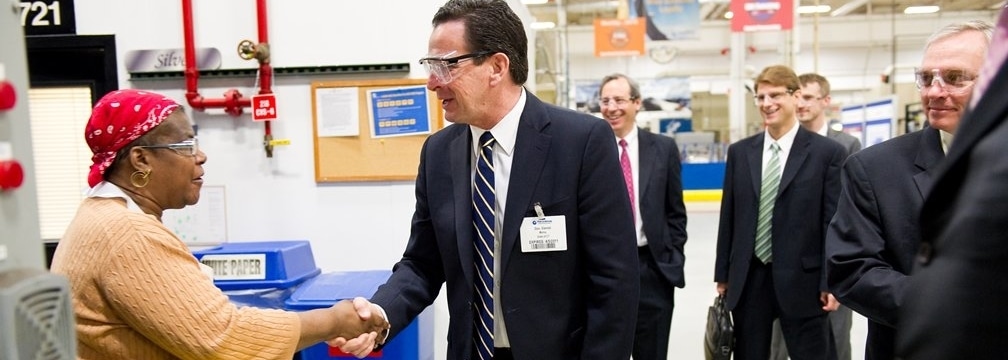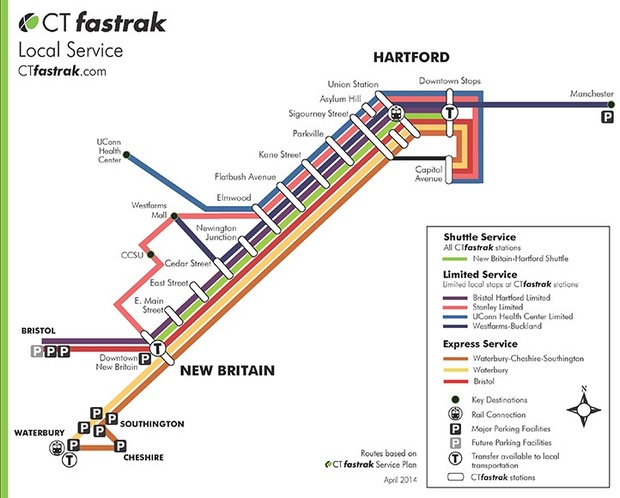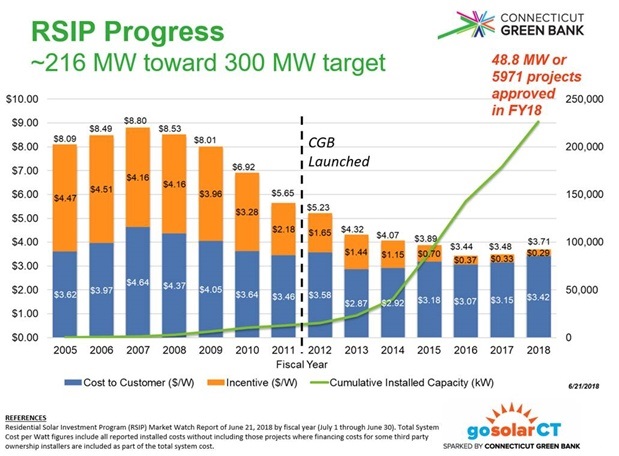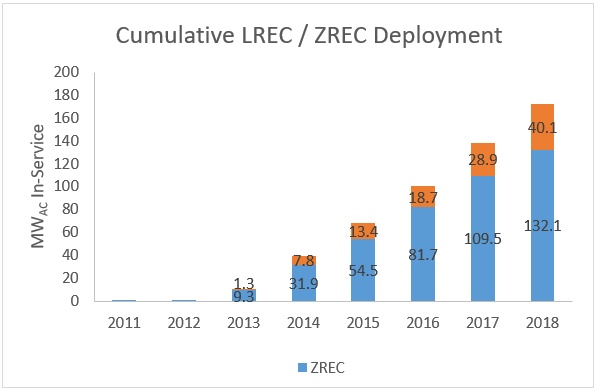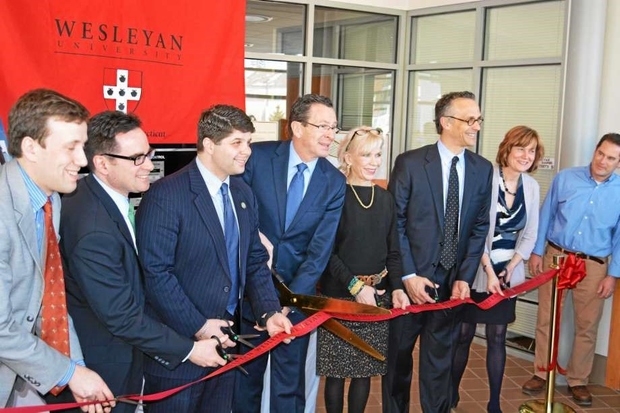|
“Reinventing Connecticut is a broad idea that revolves around one central principle — creating jobs and spurring our economy.”
—Governor Dannel P. Malloy announcing approval of plans for the Jackson Laboratory for Genomic Medicine to build a research center and create hundreds of high-paying jobs in the state, January 5, 2012
|
In his first budget address, Governor Malloy made it clear that economic development and job growth would be a defining priority of his administration. Under his leadership, the state immediately developed growth strategies to support Connecticut’s historic core industries — advanced manufacturing, insurance, and financial services — as well as begun new investments in burgeoning industries — healthcare and bioscience, digital media, technology, and tourism — designed to create jobs for the next generation.
Progress during the Malloy administration
|

|
Dropped unemployment rate from 9.3 percent in December 2010 to 4.3 percent in October 2018.
|

|
Added 126,400 private sector jobs and increased the number of new firm creation by 24 percent since the recession while Executive Branch staffing is at its lowest levels since the 1950’s. |

|
Assisted 2,100 companies by June 2018, creating and retaining more than 119,000 jobs along the way. Prior to 2011, the state had only assisted 118 companies in the previous eight years. |

|
Cemented historic partnerships with large employers including UTC, Sikorsky, Electric Boat, Cigna, ESPN, AETNA, Synchrony, and many more, to ensure their corporate headquarters presence in Connecticut for the next generation. |

|
Increased the number of Fortune 500 companies in the state from 11 to 17.
|

|
Attracted more than 100 new companies, including Charter Communications, NBC Sports, and The Jackson Laboratory. |

|
Created more than 30,000 Connecticut jobs through combined investments in renewable energy and energy efficiency.
|

|
Tripled the number of incubators in urban areas with support from CTNext and Connecticut Innovations, and created 22 new accelerators contributing to a dramatic growth in the number of new ventures and entrepreneurs in the state.
|

|
Invested approximately $206 million on brownfields revitalizing more than 250 properties in 72 cities and towns, leveraging over $3 billion in other funds.
|
| LEADING A BIPARTISAN JOBS EFFORT |
In 2011, Connecticut continued to feel the impact of the Great Recession. In addition to balancing the state budget, the Malloy administration made economic development a top priority in order to create good jobs for Connecticut residents.
After passing a budget that closed a deficit of more than $3.6 billion, Governor Malloy issued a call for a special legislative session focused on jobs and the economy. Leading into that session, the Governor embarked on a statewide tour to hear from residents and business owners for their ideas on legislation to support job growth, meeting with hundreds of companies across Connecticut. On October 6, 2011, Governor Malloy hosted an Economic Summit that combined experts and speakers from academia, the private sector, and government to discuss ways in which the state could lead the way in a 21st century economy. Later that month, he released a bipartisan strategic plan for reinventing Connecticut’s economy and strengthening the state’s overall competitiveness.[1] That plan, which has been updated[2], encompassed all key components aimed at driving economic growth including transportation, housing, education and economic development investments.
Ultimately, Public Act 11-1, An Act Promoting Economic Growth and Job Creation in the State[3] passed both chambers of the General Assembly with an overwhelming bipartisan vote on October 26, 2011. The 2011 Jobs Bill:
- Created the Small Business Express program, and directed $180 million to support small business growth;
- Increased bond authorizations for the Manufacturing Assistance Act (MAA) by $240 million;
- Authorized $20 million for brownfield remediation;
- Shortened timeframes for obtaining critical permits and eliminated burdensome regulations;
- Created a new e-business portal to make it easier for companies to access programs and services;
- Included $125 million for Connecticut innovations to make new investments in startup companies and to help build an innovation and entrepreneurship ecosystem;
- Increased the tax credit available to “angel” investors to spur private investment in high-tech and emerging technology startups;
- Included workforce development measures to align the state’s talent pipeline to business needs; and
- Directed $20 million to modernize advanced manufacturing programs within community colleges.
Small Business Express
The Small Business Express Program (EXP) was one of the first programs launched, designed to address the lack of capital available to small businesses after the great recession. The program quickly became a popular and effective tool to assist Connecticut's small business community.
Administered by the Department of Economic and Community Development (DECD), EXP provides small businesses with access to capital, job training, and encourages private investment and hiring. The program supports the retention and growth of small businesses in Connecticut using a streamlined process that provides financial assistance in the form of revolving loan funds, job creation incentives, and matching grants.
As of September 2018, DECD had awarded more than $319 million through EXP to help more than 1,950 small businesses, ranging from "mom and pop" stores to advanced manufacturing firms. These companies are expected to create more than 8,000 jobs and retain more than 21,000 jobs.

Map of small businesses that participated in DECD’s Small Business Express program since its launch in 2011.
Mid-sized Companies Help Drive Regional Economies
In addition to helping small businesses, the state recognized that medium and large-sized employers are invaluable contributors to the state’s economy, and specifically to helping drive regional economies.
Since 2011, the state was an active investor in their growth through the Manufacturing Assistance Act (MAA). In particular, MAA supports companies in the state’s most strategic industries, including advanced manufacturing, bioscience, and financial services. Between 2011 and 2018, MAA funds were used to assist 211 companies in 78 municipalities in the state’s largest urban centers, suburban towns, and small rural communities. MAA-funded companies are expected to retain approximately 37,000 jobs and create 12,600 new jobs. Approximately $587 million in total state assistance in this program has leveraged $1.6 billion in private investment.
First Five Plus
As states face constant competition for business’ facilities and headquarters, Connecticut’s high quality of talent, strategic location, and unparalleled quality of life were a strategic asset in retaining and attracting employers to the state. Creating win-win partnerships with large employers and thought-leaders would help secure jobs for not just the current population of the state, but for generations to come.
To secure the long-term viability of our targeted industries, the First Five Jobs Initiative was created through Public Act 11-86, An Act Creating the First Five Program[4] with bipartisan support of the General Assembly to provide assistance to large-scale business projects as a means of encouraging business expansion, relocation, and job creation. Companies participating in the program must promise to create 200 new jobs within two years or invest $25 million dollars and create 200 jobs within five years.
As of September 2018, 19 businesses had participated in the program, including many household-named companies such as Cigna, ESPN, NBC Sports, Deloitte, Charter Communications, Pitney Bowes, Synchrony Bank, Henkel, Amazon, and Electric Boat.
Combined, the companies pledged to retain 30,164 jobs and create at least 4,000 jobs. As of May 2018, the companies had surpassed that goal and created 4,245 jobs. Additionally, these businesses bucked the trend of slow growth in large companies and brought significant economic value through their private investment of more than $2.8 billion, leveraging 6.8 times the total state investment. The continued retention and growth of these major employers provides thousands of workers with high-paying jobs (average salaries of over $125,000) and ensures the positive economic impacts of their presence in Connecticut continues to be felt for years to come.
| STRENGTHENING ADVANCED MANUFACTURING |
With more than 4,500 manufacturing companies in Connecticut, advanced manufacturing is and will remain a critical part of Connecticut’s economy. From 2011 to 2018, the state made significant investments to turn the industry around by ensuring all manufacturers had access to state-of-the-art technologies and equipment, as well as continued access to our highly skilled talent pipeline. These investments helped foster an environment of long-term sustainability and success for Connecticut manufacturers.
Going back to the 1980s, Connecticut lost 100,000 manufacturing jobs. In 2011, the state’s response was to bring back advanced manufacturing by working with companies of all sizes, as well as universities and colleges to ensure Connecticut was best prepared to support advanced manufacturing work. Recognizing the rising global demand for aerospace and the evolving United States defense strategy, the state positioned itself to leverage these trends and build upon Connecticut’s high quality, high-productivity, and location for precision manufacturing. In particular, the strategy was designed to:
- Build long-term relationships with the largest companies in the State of Connecticut;
- Ensure that small to mid-sized supply chain companies would benefit from growth happening across the sector;
- Develop a more robust pipeline of well-trained talent (from factory floor to Ph.D. engineers); and
- Provided companies with access to capital to strategically invest in equipment and people.
United Technologies
On February 26, 2014, a historic agreement with United Technologies Corporation (UTC) that ensured the Fortune 100 Company’s presence in Connecticut for the next generation was announced. The agreement had, and continues to have, a positive impact on more than 75,000 jobs in the state.
Under the agreement, UTC pledged to invest up to $500 million to upgrade and expand its aerospace research, development, and manufacturing facilities between 2014 and 2019. Overall, UTC expects to invest up to $4 billion in research and other capital expenditures in the state.
In 2017, the United Technologies Research Center unveiled its new expanded $60 million innovation hub on its East Hartford campus made possible by the collaboration with the state. UTC then committed to investments of $75 million in an Additive Manufacturing Center of Excellence and a $40 million Engine Compressor Research facility in Connecticut.
Sikorsky/Lockheed Martin
Sikorsky, headquartered in Connecticut for more than 85 years was purchased by Lockheed Martin in November 2015 from United Technologies. Competition ensued as Lockheed Martin considered numerous states for production of nearly 200 CH-53K King Stallion Helicopters — the world’s premier heavy lift helicopter — for the United States Navy. Despite stiff competition, Lockheed Martin and Sikorsky chose to build in Stratford where they had access to skilled laborers and strong workforce.
The agreement with Lockheed Martin resulted in secured Sikorsky Aircraft's worldwide headquarters in Stratford through at least 2032, and a commitment to create and retain approximately 8,000 direct jobs. As part of the agreement, Sikorsky also pledged to nearly double its spending of $350 million per year among in-state suppliers — a boon for the thousands of small and mid-size advanced manufacturers in Connecticut.
In exchange, the state committed financial incentives totaling up to $220 million in earned annual grants and tax credits over the term of the agreement. Legislation approving this agreement was passed the General Assembly by an overwhelming, bipartisan vote of 35-1 in the State Senate and 136-6 in the House of Representatives.
Manufacturing Innovation Fund
With strategic investments in UTC, Sikorsky, and Electric Boat expected to result in a ramp up of production and hiring, the Manufacturing Innovation Fund (MIF) was introduced in 2014, to help small to mid-sized manufacturers in the state modernize, invest, and grow. Since the program’s inception, MIF has strengthened the aerospace and shipbuilding supply chain, connected manufacturers with innovative new technologies, and updated the state’s apprenticeship and training programs. As of June 30 2018, the MIF had assisted more than 1,130 companies and invested more than $58 million to help accelerate growth, cultivate talent, and boost investment in innovation.
| PRESERVING THE NAVAL SUBMARINE BASE AND STRENGTHENING ELECTRIC BOAT |
In 2011, the state recommitted to preserve and enhance the state’s 150-year-old relationship with the U.S. Navy and the Submarine Base (SUBASE), which generates $5 billion in annual economic activity and supports over 15,000 jobs. Connecticut has actively partnered with SUBASE by funding vital infrastructure improvements to support the base’s national security mission. Thanks to this partnership, SUBASE, once pegged for closure, was described by Navy Secretary Ray Maybus as, “one of our absolute crown jewels,” during a 2016 ceremony at which he presented Governor Malloy with the Distinguished Public Service Award — the U.S. Navy’s highest civilian award for public service.
This commitment to the SUBASE was particularly crucial during the recent period of federal fiscal austerity (and Pentagon requests for another round of base closures) following passage of the Budget Control Act in 2011 which severely constrained the growth of defense funding. Despite tight budgets, SUBASE has thrived and modernized, in large part because of this unique partnership with the state. Navy Secretary, Richard Spencer, in a 2018 correspondence with Governor Malloy described it as a “model relationship for the rest of the country.”
While investments in our submarine industrial base are concentrated in southeastern Connecticut, the impacts are felt statewide. For example, more than 900 suppliers in the Virginia-class program, are dispersed across all five of the state’s congressional districts, with the largest concentration in central Connecticut’s 1st District. All together, they supply more than $1 billion worth of goods and services over a five-year period. Connecticut’s continued support of the SUBASE will be beneficial for decades to come.
Transformation of the SUBASE
Over the last ten years, in partnership with Connecticut, the SUBASE has undergone a transformation as old infrastructure is demolished and replaced with modern capacity specifically designed for unique operations, specialized training and high-tech support functions associated with producing and maintaining our nation’s submarine force.
Since 2011, Connecticut has invested more than $16 million in improvements to the SUBASE, which included construction of new buildings to support operations and maintenance, construction of training equipment, utility upgrades to enhance efficiency, and purchases of land for encroachment mitigation on the northern, southern and western boundaries of the base.
Furthermore, the state initiated discussions with the U.S. Navy that resulted in two new projects to enhance the base. The first strengthens SUBASE’s storm resiliency and provides energy security to the base by funding installation of a microgrid. This will allow SUBASE to disconnect from the community utility grid during a power disruption and dispatch power through the on-base microgrid to mission critical loads, such as homeported submarines. The second project funds and relocates the main gate construction of a consolidated emergency management center to enhance SUBASE’s military value and base security.
Central to the argument Connecticut advanced in the last Base Realignment and Closure (BRAC) round was that the SUBASE deserved greater credit for the unparalleled synergy created by the close proximity and interactions among so many public and private submarine defense industry and Navy organizations in Groton and New London. Submarines are designed and built at Electric Boat in Groton and all submarine personnel receive basic and advanced training at the Naval Submarine School on SUBASE. A navy SUBASE depended on securing Electric Boat, another goal achieved by the administration.
Electric Boat – General Dynamics
Connecticut-based General Dynamics Electric Boat (EB), is the world’s premier designer and builder of nuclear submarines and one of the state’s largest employers. Since 2011, the State and Electric Boat have collaborated on two historic investments, which affirm Connecticut’s continued commitment to grow jobs and remain the global leader in the construction of nuclear submarines.
In October 2014, the state announced an agreement with EB to help finance the company’s expansion in Groton. Under the terms of this agreement, DECD provided a $10 million loan to EB in support of $31.5 million project, led to the company adding 200 employees to its 8,700 workforce in July 2015.
In May 2018, Electric Boat and Connecticut reached a historic First Five Plus agreement supporting the company’s major expansion, as well as maintaining its headquarters and primary submarine facility in the state. Through the agreement, 1,900 new Connecticut-based jobs in the state are anticipated and approximately 11,000 jobs will be retained. Senator Cathy Osten, a longtime supporter of job expansion and retention, played an integral role in the advancement of Electric Boat. The deal allows the company to retain and enhance its ability to bid competitively on U.S. Navy contracts, which will positively impact jobs for the next generation and beyond.
Under the agreement, the state committed to provide assistance over 17 years with certain minimum requirements, targets and associated benefits. This includes a sales and use tax exemption with a value of up to $20 million related to capital expenditures of at least $852 million, $8 million for workforce development, $20 million for assistance with dredging related to the company’s growth, and the provision of a loan of $35 million where loan forgiveness may be earned for achieving employment and supply company spend targets.
Healthcare and bioscience promise to be strong drivers of employment in the coming decade. Traditional jobs in healthcare delivery will grow with the aging of the baby boomers and their need for additional healthcare services. Connecticut will see growth from its strong position in life sciences (including pharma, medical devices, and genomics) due to the strength of the university research community — mainly the University of Connecticut (UConn) and Yale — and the strong array of companies expanding their Research & Development and manufacturing presence in the state.
Given bioscience’s potential for growth and Connecticut’s strategic location in the heart of the Knowledge Corridor, targeting strategic investments in the industry was an obvious choice. Bolstered by the state’s educated and productive workforce, with the sixth highest percentage of science and engineering doctorates in the nation, Connecticut quickly established itself as a bioscience hub focused on job creation and economic growth.[5]
To leverage these strengths, the state made strategic investments. In 2011 the state undertook a major bioscience investment of $864 million at UConn Health aimed to improve research and development at the Medical School. This was followed by Science Technology Engineering and Math (STEM) funding for UConn of $1 billion over ten years. The goal was to dramatically increase our talent base in key science areas.
The Jackson Laboratory
To gain more momentum and be more competitive, the state also needed to attract more private sector participation. Governor Malloy’s plan to invest in bioscience started with the recognition that investing in UConn Health would signal the state’s commitment to the industry at large. This announcement quickly generated interest from The Jackson Laboratory (JAX), a world-renowned research institute.
In September 2011, the state announced a $1 billion initiative with JAX bringing the lab’s new personalized medicine facility to the campus of UConn’s Health Center. JAX created 385 positions by 2018, achieving their commitment of at least 300 positions four years ahead of schedule.
Once JAX Genomic Medicine is fully developed, the institute is expected to employ 600 scientists and technicians in 250,000 square feet of state-of-the-art lab space. The total 20-year capital and research budget for the institute is projected to be $1.1 billion, of which the State of Connecticut has approved $291 million: $192 million in a secured, forgivable construction loan and $99 million in grants for research and related activities.
As of June 2018, the bioscience cluster in Connecticut was composed of nearly 39,000 employees at more than 2,500 companies.[6] Many other bioscience entities identify Connecticut as a hub and have relocated to the state, significantly, Sema4 and SCA Pharmaceuticals.
Connecticut Bioscience Innovation Fund
The State of Connecticut demonstrated a commitment to facilitating forward-thinking work in the bioscience field with the creation of the Connecticut Bioscience Innovation Fund (CBIF) in 2013. As of June 2018, the CBIF had invested more than $61 million in innovative and promising bioscience research and companies.
| BOLSTERING THE INSURANCE & FINANCIAL SERVICES SECTOR |
From 2011 to 2018, the state supported the insurance industry, making Connecticut an attractive home, through regulatory efficiency, premium tax reduction, incentives, and other reforms which solidified and grew the sector. For more than 150 years, Connecticut has been the center for insurance excellence. Connecticut leads the nation in insurance jobs per capita (2.6 percent), the insurance industry in the state accounts for nearly 60,000 direct jobs and 114,000 indirect jobs in state, and has the highest concentration of actuaries in the country.
This commitment to state-based insurance regulation gave Connecticut an important voice in national and international discussions to ensure the state’s domestic insurance and reinsurance industry will continue to compete vigorously across the U.S. and globally. With 111 companies domiciled in the state — including industry leaders The Hartford, Travelers, Aetna, Cigna, Hartford Steam Boiler, Voya, Gen Re, and Odyssey — the Connecticut insurance industry accounts for $170 billion in direct written premiums. In addition, the state has over 1,300 non-domestic insurance companies licensed to do business here.
Incubators
The insurance industry is utilizing technology and innovation to provide better service to its customers. Since 2011, Connecticut’s solid industry base gave rise to companies like InsurTech, Connecticut’s first insurance accelerator, which is increasing innovation and startups, as well as developing a strong pipeline of talent.
The state capitalized on the captive insurance market by enabling legislation and subsequent supporting legislation to create a captive insurance market, which did not exist before 2011. As of June 2018, the industry accounted for more than $360 million in premiums and provided businesses of all sizes and disciplines with a tool to manage their costs. This gave rise, among other things, to Connecticut becoming a home to captive insurers created by some of the largest state-based corporations such as Aetna, Stanley Black & Decker, and Charter Spectrum, as well as mid-size employers like MasoniCare, grocery chains, and the trucking and construction industry.
Hedge Funds and Venture Capital Investment
In addition to the robust insurance industry, Connecticut benefits from the presence of myriad of other financial services organizations, including private equity firms, hedge funds, venture capital firms, and several national and international banks. The finance industry in Connecticut is projected to grow by as much as 30 percent by 2024.[7] In 2016, finance and insurance accounted for 12.8 percent of the state’s gross domestic product.[8] With more than 100,000 insurance and financial service employees, Connecticut has a vast array of talent in the industry.
The state is currently second in assets managed in hedge funds with more than $300 billion managed by Connecticut firms. Given the strength of this sector and the large amount of data gathered by Connecticut companies, there is also growing presence of data analysis, data management, and cyber security firms in the state, including global companies such as Infosys and Gartner.
To support these key industries, the Malloy administration:
- Partnered with industry groups such as the Insurance and Financial Services Cluster to promote educational programs focused on the specialized accounting, actuarial, and legal aspects of the industry;
- Promoted Connecticut’s regulatory environment and talent at conferences designed to attract firms from around the country and the;
- Extended tax and other incentives designed to promote the industry; and
- Signed legislation to protect Connecticut residents and employers from the negative effects of the federal Republican tax law that was adopted by Congress and signed by President Trump in 2017. Among the changes was a revenue-neutral tax on pass-through entities, fully offset by a personal income tax credit, which prevented Connecticut’s small business owners from being targeted by the federal tax law.[9]
While Connecticut may not be rich in natural resources, it does have a vibrant green tech sector that has grown to 30,000 jobs, representing an important part of our state economy. A national leader in fuel cell manufacturing and home to a productive solar installation industry, Connecticut is now leveraging its manufacturing expertise to become the east coast hub for offshore wind assembly.
Fuel Cells
For fifty years, Connecticut has evolved fuel cells to be a viable alternative energy source. Under the leadership of the administration and the Representatives David Arconti and Michelle Cook, Connecticut’s homegrown fuel cell sector benefitted and grew thanks to state support for long-term commitments investing in fuel cell deployment across Connecticut. Altogether, over the life of Connecticut’s long-term procurements, the state will have invested nearly $1 billion in incentives to deploy 100 megawatts (MW) of fuel cells throughout the state — a more significant per capita investment than states like California. With a strong manufacturing presence and industrial supply chain in Connecticut, the industry generates approximately $601 million in revenue and investment annually.
Offshore Wind
As the price of offshore wind falls, Connecticut has seized this new opportunity. Governor Malloy called for the first significant state investment in wind energy, and in a 2018 procurement, 200 MW of offshore wind was added to the state’s energy portfolio. With this wind contract comes a $15 million private investment in infrastructure improvements to the New London State Pier to support construction and assembly on wind turbines and to spur significant economic development with additional offshore wind development. The wind project is expected to lead to the creation of more than 1,400 direct, indirect and induced jobs.
Finally, green tech jobs are precisely the kind of well-paying, skilled jobs that the state needed to invest in to cultivate a talent pipeline. In collaboration with our community colleges, the state helped to initiate an Innovative Energy Management Associates program to close this workforce gap. [For more on fuel cells and offshore wind see “Tackling Climate Change with Cleaner, Cheaper, More Reliable Energy Policy” on page 52]
In 2011, the Governor’s Cabinet on Nonprofit Health and Human Services was established. Its purpose is to analyze existing public-private partnerships with respect to the state's health and human services delivery systems and to make recommendations to the Governor to enhance the effectiveness of those systems in regard to client outcomes, cost-effectiveness, accountability and sustainability. Since its creation, the Cabinet has developed and presented 62 recommendations to the Governor based on the premise that a financially viable human services delivery system is vital to the health, quality of life and economic well-being of the state.
Nonprofits serve our neediest citizens, in many ways. In 2013, the state launched the first-ever Nonprofit Grant Program (NGP), which funds capital projects for nonprofit health and human services providers. These projects enable community-based providers to undertake energy efficiency, building improvement, information technology and other capital improvement projects that create efficiencies and service delivery improvements. As of June 30, 2018, approximately $105 million in NGP funding had been awarded, close to 600 projects, and another $30 million in July 2018.[10]
Digital media is a fast-growing creative industry that is comprised of production and post-production facilities, digital animation, film, and gaming companies. Since 2006, average spending in this industry in Connecticut has been $200 million per year.[11] Already home to many digital media industry giants such as ESPN and WWE, television networks such as YES and A&E, and talk show and digital movie studios like Blue Sky Studios, a division of 20th Century Fox, digital media was another industry the state targeted for growth.
Recognizing its potential, further the state supported attractive tax credit programs competitive with other key states. Additionally, the state fostered the creation of two UConn undergraduate degrees in digital media and design. The degrees are cross-disciplinary programs intended to give Connecticut students a competitive edge for career success in the rapidly growing job market and to provide employers with skilled talent they need to expand.
Connecticut’s favorable policies and efforts culminated in innovative and influential companies like NBC Sports, Charter Communications, and ITV relocating to Stamford, Connecticut.
| TECHNOLOGY AND INNOVATION |
Connecticut has always been home to innovative people and companies. The state’s highly educated and productive workforce provides companies of all types with a major competitive advantage.
Companies like Infosys and Ideanomics announced plans to establish operations in the state due to several competitive strengths. First, tech talent is easier to access and more affordable than many other metropolitan areas in the U.S. Companies understand Connecticut’s cutting-edge educational systems produce an enormous level of talent that can drive future success and business growth. Second, the state’s smaller size leads to easier access to leaders in business, government and capital providers helping enterprising companies grow and innovate.
In order to ensure that Connecticut maintained—and strengthened—its competitive position in the technology and innovation arenas, the state took the following steps:
- Provided $125 million to Connecticut Innovations (CI) to accelerate growth in young, entrepreneurial companies. CI dramatically increased its work to support early stage companies with needed capital as well as the development of innovation ecosystems in the state through its subsidiary, CTNext. In 2017, CI invested $38 million in 74 companies and had 158 companies in its portfolio as of June 2018.
- Seeded with $10 million in the Tech Talent Fund, which is focused on building the high-tech workforce pipeline that employers need, both now and in the future. Major fund initiatives include new boot camps for in-demand IT sectors and technology internships support, bringing employers together with the talent around the state.
- Created the first in the nation, “Green Bank”, to help companies and consumers finance clean energy projects to lowering their energy costs.
- Increased the number of bachelor’s degrees in computer science at public colleges and universities by 136 percent and by 81 percent in private colleges and universities during that same period.
- Launched the Innovation Places program in 2017, designed to create compelling urban areas, which would welcome entrepreneurs, innovators and their business partners. Four cities in the state are now creating strategic place making investments in incubators and accelerators, mentor networks, bike paths, and other elements. Together, these changes are already helping the state dramatically grow the innovation sector, with new company creation up considerably in 2017.
Connecticut’s tourism marketing was practically non-existent before 2011, having at one point been reduced to a single dollar. This was allowed to happen despite the state’s natural beauty, diverse arts community, cultural activities and events, and premier destinations being tremendous economic assets.
Connecticut went from being completely excluded from New England tourism maps to being a $14.7 billion tourism industry. Key to the state’s economic development strategy, and even in the midst of extremely challenging budget circumstances, Governor Malloy made tourism funding a priority once again. Connecticut launched the award-winning[12] “Still Revolutionary” marketing and branding campaign in 2012, including the new CTvisit.com, which promotes more than 4,000 different hotel, restaurant, attraction, and event partners. Since 2011, the state made huge gains in reestablishing as a prime Northeast destination.
After just four years of a renewed focus on the industry:
- Tourism contributed $14.7 billion to the local economy in 2015 (total business sales) — a 4.6 percent increase since 2013.
- Tourism supported 82,688 direct jobs in 2015 — a 2 percent increase over 2013 — and 121,527 jobs were indirectly supported by tourism activities.
- One of every 18.8 jobs (5.3 percent) of all employment in Connecticut was supported by visitor spending in 2015.
- Tourism generated $1.7 billion in tax revenues in 2015, including $910 million in state and local taxes.
- Direct traveler spending totaled $8.7 billion in 2015, up 5.1 percent from 2013.
- Traveler spending increased by $1.5 billion since the recession — 20 percent higher in 2015 than in 2009.
| MODERNIZING CONNECTICUT'S LIQUOR LAWS |
Connecticut’s liquor laws are the most antiquated liquor laws in the country. These archaic laws have resulted in higher prices for Connecticut customers and lost sales to neighboring states.
Rolling Back Connecticut’s Blue Laws
Prior to 2012, consumers could not legally purchase alcohol on Sundays in Connecticut. To make Connecticut competitive once again and to provide our citizens with convenience in their purchases, Governor Malloy introduced and signed into law Public Act 12-17, An Act Concerning Competitive Alcoholic Liquor Pricing and Hours of Operation for Permittees.[13] This law allows off-premises sale and dispensing of alcohol on Sundays from 10:00AM to 5:00PM and on the following holidays: Memorial Day, Independence Day, and Labor Day. In 2015, Liquor store hours were statutorily extended again by one hour each day for off-premises alcohol sales.[14] In addition to expanding store hours, the law also allows farmers market wine sales permittees to sell wine on any day between the hours of 8:00AM and 9:00PM.
Because the legislature was not prepared to fully eliminate the unfair “minimum bottle” pricing scheme, Public Act 12-17 took Connecticut a step forward by allowing retailers who sell for off-premise consumption to sell one item below cost each month.
Building off the 2015 reforms, Governor Malloy supported and signed legislation that[15]:
- Created an alcoholic manufacturer permit to allow manufacturers who produce less than 25,000 gallons of alcoholic liquor in a calendar year to sell, at retail, their product on their premises for off-premises consumption.
- Allow cider manufacturers to offer free samples of their product.
- Created a farmers market beer sales permit that allows manufacturers to sell their product at up to three farmers market locations a year.
While great strides were made over the last eight years, work remains to further increase economic activity in the state. With more than 126,000 jobs added since the recession, the state is on the right course. At the same time, many areas need continued attention.
If Connecticut wants to continue to be competitive, the state should focus its attention on retaining and supporting companies that are in targeted industry clusters where Connecticut has the best opportunity for growth: advanced manufacturing, bioscience, insurance and financial services, and tech-based areas such as green technology. With thousands of advanced manufacturing and technology jobs expected to come online because of strategic investments in these industries, Connecticut must continue to invest in STEM education, which provides the pipeline of talent that will be needed to fuel the state’s economy.
A major focus should be to further enhance Connecticut’s urban centers to attract a younger workforce. Live, work, play initiatives can be leveraged to highlight the state’s cities as attractive alternatives to the big city congestion of the northeast. In addition, the state should continue to invest in the innovation ecosystem in our urban centers to foster both economic activity and urban excitement.
Transportation is another critical factor for companies in the state. Repeatedly, it is a decision factor in where businesses grow or relocate according to surveys. The state must continue to invest in infrastructure, including rail, highway, bus, bike, and high-speed internet.
While the economic development toolbox improved under the Malloy administration, restructuring of certain tax credits is in order. The most effective programs require recipients to deliver jobs, capital expenditures and other promises before they can receive financial assistance. In this way, the state is assured that the benefits the state incentivizes are delivered with positive return on state investment. Each of the tax credit programs should be reviewed to ensure they are endowed with these types of specific conditions for funding. We also strongly recommend that successful programs, such as the Small Business Express, Manufacturing Assistance Act, Manufacturing Innovation Fund, Bioscience Innovation Fund, be continued with a disciplined eye on producing a positive return on investment for the state. To be competitive globally, Connecticut needs to continue with strategically crafted and targeted incentive programs. With, close coordination with other state agencies can leverage community investments. Ensuring a cohesive strategy, across the state and with key business and local partners, will ensure more impactful investment for each economic development dollar spent. Further, to keep tourism growing and thriving in the state, there needs to be an increase in the level of funding for the Statewide Tourism Fund, returning to at least $15 million annually to ensure Connecticut is competitive with surrounding states. We also recommend that the state Welcome Centers be re-opened and appropriately staffed by tourism personnel.
In order to foster a more competitive marketplace for liquor and promote fairness to Connecticut consumers, the state-mandated price fixing mechanism known as “minimum bottle” needs to be repealed. Connecticut consumers deserve convenience that can support businesses of all sizes, craft breweries to family package stores and groceries. Connecticut’s package stores could also benefit by selling a wider variety of complementary products and filling craft beer. Another improvement for consumers would be to permit the sale of wine in grocery stores.
Successful economic development requires a comprehensive understanding of economic drivers as well as engagement with the critical stakeholders in the state. While much progress was made in the Malloy years, failure to continue to invest in the key levers of economic growth as described above could reverse the progress to our business climate.
1. Reinventing Connecticut: An Agenda for Action in the Special Session on Jobs
2. 2018 Economic Development Strategy
3. Public Act 11-1: An Act Promoting Economic Growth and Job Creation in the State
4. Public Act 11-86: An Act Creating the First Five Program
5. 2017 Connecticut Economic Review, Eversource (DECD 2018 Strategic Plan)
6. Economic Modeling Specialists International, 2016 (DECD 2018 Strategic Plan)
7. Connecticut Economic Resource Center, 2014 (DECD 2018 Strategic Plan)
8. U.S. Bureau of Economic Analysis, 2016 (DECD 2018 Strategic Plan)
9. Public Act 18-49: An Act Concerning an Affected Business Entity Tax, Various provisions Related to Certain Business Deductions, the Estate and Gift Tax Imposition Thresholds, the Tax Treatment of Certain Wages and Income and a Study to Identify Best Practices for Marketing the Benefits of Qualified Opportunity Zones
10. Office of Policy and Management: Success Stories of the Nonprofit Grant Program
11. 2018 Economic Development Strategy
12. Since its launch in 2012, Connecticut still revolutionary marketing efforts have been recognized with 34 awards for public relations, advertising, social media and website development from several prominent organizations, including the Public Relations Society of America (PRSA), Hospitality Sales & Marketing Association International (HSMAI), United States Travel Association (USTA), the CT Ad Club and International Economic Development Council (IEDC).
13. Public Act 12-17: An Act Concerning Competitive Alcoholic Liquor Pricing and Hours of Operation for Permittees
14. Public Act 15-244: An Act Concerning the State Budget for the Biennium Ending June 30, 2018 and Making Appropriations Therefor, and Other Provisions Related to Revenue, Deficiency Appropriations and Tax Fairness and Economic Development
15. Public Act 15-24: An Act Concerning Alcoholic Liquor
|
